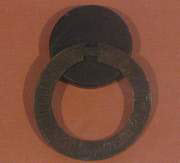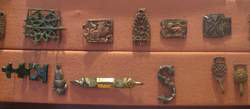Abandoned Communities ..... Dunwich
In theory it would have been possible to maintain the harbour much as it was, but to use the new exit to sail out into the sea. However, for the people of Dunwich this would have entailed travelling up the River Dunwich and passing close to Walberswick. They would no longer have been able to charge tolls for boats going past Dunwich. On the contrary they would have faced the prospect of having to pay tolls themselves as they went past Walberswick.
Over the next two or three years the people of Dunwich took on the enormous task of cutting a new channel near their own town and also closing up the channel that had formed near Walberswick. The new channel was not cut through the shingle of Kings Holme, but through firmer ground further south. As pointed out by Rowland Parker, it would have passed through part of the town itself. A number of residents would have been displaced, and Parker assumes that they would have left Dunwich altogether. As they lived in the area close to the docks they would probably have been poorer people, and the remaining residents of Dunwich may have had little interest in persuading them to remain.
In March 1286 the combination of high tides and strong easterly winds caused even greater devastation. In particular a strip of land down the eastern side of the town, in places a hundred metres wide, was eroded by the sea. Residential areas, churches, and a small monastery were carried away. The priory of Grey Friars was almost totally demolished, only the graveyard and the west wall of its chapel remaining in existence. Massive waves swept across Kings Holme and flooded the lower town. The harbour mouth seems to have stayed open, but further north the River Blyth again forced a way through Kings Holme at or near the point where the previous opening had been.
There is no doubt that the events of 1286 must have been experienced by the people of Dunwich as an enormous catastrophe. We do not have direct access to their emotional reactions, not even in the form of eye witness accounts, but from the nature of the events and relevant documentary evidence it is possible to make some guesses about the general pattern of their psychological responses. One concept that has been applied to recent community disasters is the notion of collective efficacy. Collective efficacy is the general belief within a group or community that shared aims can be achieved by joint action. Research by Benight has shown that after flash floods caused devastation and two deaths in Buffalo Creek, Colorado, USA, in 1996 a high level of collective efficacy protected residents against suffering excessive distress one year after the disaster.
See Albert Bandura , Exercise of Human Agency through Collective Efficacy, Current Directions in Psychological Science 2000 9 75-78, available at this address. For the Benight study see Benight, C.C., Collective Efficacy following a Series of Natural Disasters, Anxiety, Stress and Coping, 2004 17 401-420.
After the great storm of March 1286 it appears that the people of Dunwich did not act in a united fashion, that the level of collective efficacy was by no means high. For one thing, a new mayor and set of four bailiffs were elected in 1286 to govern the town, and then again in the following year another group of mayor and bailiffs were elected. It seems clear that there was much dissatisfaction with the performance of the governing group, quite possibly reflecting a tendency to blame the mayor and bailiffs for not taking measures that might have alleviated the damage done by the storm. Moreover, in October 1287 a commission consisting of two knights of the shire was established to inquire into a conspiracy of twenty one men. It was alleged that this group of men had taken an oath whereby, among other things, they had vowed not to permit the court of the mayor and bailiffs to be held, nor to permit the king's dues to be levied, nor to allow the king's writs and judgements of the king's court to be carried out, and not to allow the peace to be kept by the mayor and bailiffs. We have no record of the outcome of the inquiry, but the fact that it had to be held indicates that there was much discontent during this period.
At the same time conflict with people living in the villages to the north was intensified. Once again the men of Dunwich insisted on closing the opening to the sea near Walberswick. However, a document of 1300 tells us that a group of people came by night and re-opened the port to allow the River Blyth to flow straight into the sea. In addition, they broke down certain causeways in such a way that the channel leading towards Dunwich was impeded. As argued by Rowland Parker the conflict could only have been resolved in a satisfactory manner if the people of Dunwich and the inhabitants of the northern villages had been prepared to discuss the issues between them, and to negotiate with a view to reaching an agreement that would have been in the best interests of all concerned. But by 1300 it is clear that the level of hostility was such that no discussion was possible.
Rows over tolls continued. To ensure collection of tolls from boats passing close to Dunwich a "guard house" was built on Kings Holme. But in 1324 some men from Walberswick mounted a raid in which they burnt down the guard house, killed a bailiff, William Scott, who was there to collect the tolls, severely beat up his companion, and took away oxen and horses to the manor of Blythburgh.
Over the next two or three years the people of Dunwich took on the enormous task of cutting a new channel near their own town and also closing up the channel that had formed near Walberswick. The new channel was not cut through the shingle of Kings Holme, but through firmer ground further south. As pointed out by Rowland Parker, it would have passed through part of the town itself. A number of residents would have been displaced, and Parker assumes that they would have left Dunwich altogether. As they lived in the area close to the docks they would probably have been poorer people, and the remaining residents of Dunwich may have had little interest in persuading them to remain.
In March 1286 the combination of high tides and strong easterly winds caused even greater devastation. In particular a strip of land down the eastern side of the town, in places a hundred metres wide, was eroded by the sea. Residential areas, churches, and a small monastery were carried away. The priory of Grey Friars was almost totally demolished, only the graveyard and the west wall of its chapel remaining in existence. Massive waves swept across Kings Holme and flooded the lower town. The harbour mouth seems to have stayed open, but further north the River Blyth again forced a way through Kings Holme at or near the point where the previous opening had been.
There is no doubt that the events of 1286 must have been experienced by the people of Dunwich as an enormous catastrophe. We do not have direct access to their emotional reactions, not even in the form of eye witness accounts, but from the nature of the events and relevant documentary evidence it is possible to make some guesses about the general pattern of their psychological responses. One concept that has been applied to recent community disasters is the notion of collective efficacy. Collective efficacy is the general belief within a group or community that shared aims can be achieved by joint action. Research by Benight has shown that after flash floods caused devastation and two deaths in Buffalo Creek, Colorado, USA, in 1996 a high level of collective efficacy protected residents against suffering excessive distress one year after the disaster.
See Albert Bandura , Exercise of Human Agency through Collective Efficacy, Current Directions in Psychological Science 2000 9 75-
After the great storm of March 1286 it appears that the people of Dunwich did not act in a united fashion, that the level of collective efficacy was by no means high. For one thing, a new mayor and set of four bailiffs were elected in 1286 to govern the town, and then again in the following year another group of mayor and bailiffs were elected. It seems clear that there was much dissatisfaction with the performance of the governing group, quite possibly reflecting a tendency to blame the mayor and bailiffs for not taking measures that might have alleviated the damage done by the storm. Moreover, in October 1287 a commission consisting of two knights of the shire was established to inquire into a conspiracy of twenty one men. It was alleged that this group of men had taken an oath whereby, among other things, they had vowed not to permit the court of the mayor and bailiffs to be held, nor to permit the king's dues to be levied, nor to allow the king's writs and judgements of the king's court to be carried out, and not to allow the peace to be kept by the mayor and bailiffs. We have no record of the outcome of the inquiry, but the fact that it had to be held indicates that there was much discontent during this period.
At the same time conflict with people living in the villages to the north was intensified. Once again the men of Dunwich insisted on closing the opening to the sea near Walberswick. However, a document of 1300 tells us that a group of people came by night and re-
Rows over tolls continued. To ensure collection of tolls from boats passing close to Dunwich a "guard house" was built on Kings Holme. But in 1324 some men from Walberswick mounted a raid in which they burnt down the guard house, killed a bailiff, William Scott, who was there to collect the tolls, severely beat up his companion, and took away oxen and horses to the manor of Blythburgh.
Three
This copper alloy brooch from the early fourteenth century was used to fasten the top of a lady’s cloak. It was owned by Dame Hawyns Poynings. It was found buried with the owner’s heart in Greyfriars monastery.
Buckles, belt fittings, and belt ends
A purse frame and some keys
Cooking pots from the thirteenth and fourteenth centuries
These objects are on display at the Dunwich museum



